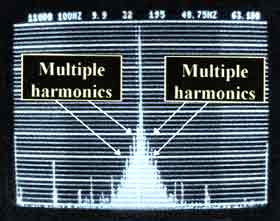Coal Conveyor Motor Drive
Test
Objective
To analyse a current spectrum from a low speed conveyor driven via a gearbox
and induction motor.
Nameplate
details
3-Phase, 415 V, 211 A,
170 h.p/127 kW., 50 Hz, 1480 r.p.m,
SCIM.
Full-load slip = 0.0133 or 1.33%.
Additional
Information
Drive information was available from Power Station staff:
Gearbox input/output ratio = 3/67
Output speed at full-load = 1480/(3/67) = 66.27 r.p.m.
Rotational speed frequency of output shaft of gearbox = 66.27/60 = 1.1 Hz
It was not known whether it was a 2 or 3 stage reduction gearbox - hence additional mechanical influences may exist.
At
full load the current components at the following
frequencies can occur around the 50 Hz component:
± 1.1
Hz, and ±2sf1 (from broken rotor bars) = ±
1.33 Hz. Harmonics of ±1.1 Hz can also occur.
Motor opertating at reduced load
Actual
input current = 130 A
Full-load current = 211
A
I input = 61% of full-load current.
Author's prediction of operational slip (±10%) at reduced current = 0.0066, Actual Motor Speed = 1490 r.p.m., therefore sidebands due to broken bars = ±0.66 Hz

Figure m-6,
Current Spectrum
0 - 400 Hz 0.25 Hz/line

Figure
m-7, Current Spectrum
45 - 55 Hz 25 milliHz/line
The ammeter
reading was relatively steady compared to the previous Coal Crusher (Mill)
motors (Mechanical Influences Case History 1) hence the smearing effect
in the spectrum should not be so nearly pronounced.
The full-load slip is 1.33% giving twice slip frequency sidebands at ±1.33
Hz.
Figure m-6 shows the spectrum after averaging and a series of multiple
sidebands are present as is the typical case for conveyor drives.
As predicted there is a more definitive spectrum compared to Figure m-1
for a Coal Crusher (Mill) motor (Mechanical Influences Case History 1)
with a high fluctuating load.
Figure m-7 shows the highest sidebands in dB are at ±1.3 Hz and
they are 48dB down on f1.
There are also 2nd, 3rd, and 4th harmonics of 1.3 Hz.
A motor that actually had an inherent rotor asymmetry due to normal manufacturing
tolerances that gave a 48 dB difference (between f1
and the sidebands) would not normally exhibit multiple sidebands.
Expert
Comment
This
motor was actually operating on a reduced load taking a current of 130
A as per the accurate spectrum analysis. For this current, which is 61.6%
of the full-load current of 211 A, the estimated operational slip at this
current (for a 4-pole motor of this rating) using Thomson's confidential
algorithm is s = 0.0066 (±10%).
There are no sidebands due to broken bars in the region of ± 0.66 Hz. All the current components in Figures m-6 and m-7 are due to mechanical disturbances on the rotor from the gearbox/conveyor.
